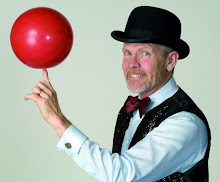Okay, here's the companion piece to the chemotherapy posting from the other day.
The radiology treatment is aimed at destroying any remaining cancer cells that still exist in the site of the primary tumor. For me, this means that I am irradiated on my left cheek and the left side of my neck -- but also on the right side of my neck, as lymph flow moves across the neck from side to side, so some cancer cells may have taken up residence to starboard as well as port.
First step in the procedure was to create a form-fitting, open-mesh nylon mask that covers my face and head (but is open on the back so that it slips on and off fairly easily). The mask has a sturdy frame built around it, so that when I lie on the irradiation table, the mask can be secured to the table immobilizing my head in exactly the same position for each treatment. The open mesh nature of the mask makes it perfectly tolerable to wear. (And the fact that the treatment itself is fairly short is a big help as well!)
Second step was to do a CT scan of my head and neck to allow my rad doc to identify with great precision exactly where he wants the radiation applied. This information is programmed into the radiation machine (Sorry I don't know what it's officially called. We haven't been formally introduced...) so that every treatment is exactly like all the others. This machine, by the way, makes your typical CT or PET machine look like a high school science project.
Every weekday, then, Deb and I drive to the radiology center and wait my turn for the machine. The waiting is usually short and there is a make-it-yourself coffee machine and baskets of cookies and pretzels to keep us occupied while someone else is getting treatment. Since most everyone gets a treatment every day at the same time, you see the same folks in the waiting area every day. That's kind of nice. We don't talk much, but it's nice anyway.
When my name is called, I'm taken to the radiation machine room, which means walking through a very large doorway, past a very thick door. And the door and doorway are somber reminders that something special is going on.
The two technicians who run the equipment are both women, and seem to enjoy their work. They're funny. If I sit on the wrong part of the table, they bark at me and tell me to pay attention!! When I tell them I need careful instruction from them, they say: "Of course you do. You're a man. Fortunately you're clever enough to realize you need the help." That kind of stuff.
They make sure that I am precisely aligned on the table -- by means of securing my mask firmly to the table and using a laser to line up a very small black tattoo that they imprinted on my sternum during my first treatment.
The mask makes it difficult to open my eyes, which is just as well. So I don't actually see them leaving. But I am absolutely sure they are on the outsice of that very large doorway, and have closed that very large door behind them. There is music playing in the room, which is a real touch of kindness. I think it's satellite radio. One day it was really nice C&W. The next day it was late-60's Folk Rock. Then modern covers of classic jazz vocals. Then Frank Sinatra. Just really nice, easy acoustic companionship.
After a while, the machine starts to make noises. Growls, clicks, whirrs -- I haven't figured out yet what noise means what, but I'm still trying. Bright lights come on now and then. And I can hear when the radiation "gun" moves from one spot to another. So I know when it's aimed at my left cheek, my left neck, and when it shifts around to my right neck.
I think the entire procedure lasts maybe 10 minutes -- from start-up to wind-down. I lie on the table until the technicians come and remove my mask. If I try to sit up too quickly, I get barked at again. They tell me that, if my head hits the radiation gun device, that I will have to pay to get it repaired. The gun, that is -- not my head...
I then get a cheery "Good-by! See you tomorrow!" from both of them.
There is no pain or feeling of heat involved in this procedure -- other than being nagged by the two technicians. I understand that the effect of the radiation is cumulative, but for now, I feel practically no effects from the procedure.
Subscribe to:
Post Comments (Atom)

Buried in this story is an example of how the US system of health care relates to the national system of the UK, for example. Here we get the treatments broken up into daily treatments, while in the UK there are only the resources to do two larger doses per week. Breaking the dose up five ways significantly reduces damage to healthy tissue. I am not arguing against national health care, but it is nice to know we sometimes actually get something superior for our huge outlays.
ReplyDeleteRandy - This is such a beautifully written piece about radiation therapy (as was the chemo piece)! As I read it, I felt as though I was there with you :) Radiation effects tend to build over time, so you may start to feel more tired etc. in a few weeks.
ReplyDeleteAlso, let me tell you a "secret" about medical staff - they almost always love doughnuts/pastry/cookies. Staff spend a lot of time running around and regular meal breaks are difficult--therefore, portable bursts of energy and happiness are crucial. If things ever get too tense, whip out one of these and notice how everyone around you gets giddy. Just a tip.
Love,
Donna P.